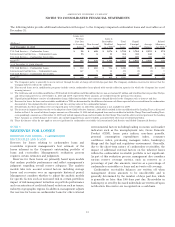American Express 2010 Annual Report Download - page 78
Download and view the complete annual report
Please find page 78 of the 2010 American Express annual report below. You can navigate through the pages in the report by either clicking on the pages listed below, or by using the keyword search tool below to find specific information within the annual report.
NOTE 3
FAIR VALUES
Fair value is defined as the price that would be received to sell an
asset or paid to transfer a liability (an exit price) in an orderly
transaction between market participants at the measurement
date, and is based on the Company’s principal or most
advantageous market for the specific asset or liability.
GAAP provides for a three-level hierarchy of inputs to
valuation techniques used to measure fair value, defined
as follows:
•Level 1 — Inputs that are quoted prices (unadjusted) for
identical assets or liabilities in active markets.
•Level 2 — Inputs other than quoted prices included within
Level 1 that are observable for the asset or liability, either
directly or indirectly, for substantially the full term of the
asset or liability, including:
– Quoted prices for similar assets or liabilities in
active markets
– Quoted prices for identical or similar assets or liabilities in
markets that are not active
– Inputs other than quoted prices that are observable for the
asset or liability
– Inputs that are derived principally from or corroborated by
observable market data by correlation or other means
•Level 3 — Inputs that are unobservable and reflect the
Company’s own assumptions about the assumptions market
participants would use in pricing the asset or liability based on
the best information available in the circumstances (e.g.,
internally derived assumptions surrounding the timing and
amount of expected cash flows).
The following table summarizes the Company’s financial assets and financial liabilities measured at fair value on a recurring basis,
categorized by GAAP’s valuation hierarchy (as described in the preceding paragraphs), as of December 31:
(Millions) Total Level 1 Level 2 Level 3 Total Level 1 Level 2 Level 3
2010 2009
Assets:
Investment securities:
(a)
Equity securities $ 475 $ 475 $ — $ — $ 530 $ 530 $ — $ —
Retained subordinated securities
(b)
— ———3,599 — — 3,599
Debt securities and other 13,535 — 13,535 — 20,208 — 20,208 —
Interest-only strip
(b)
— ———20 — — 20
Derivatives
(c)
1,089 — 1,089 — 833 — 833 —
Total assets $ 15,099 $ 475 $ 14,624 $ — $ 25,190 $ 530 $ 21,041 $ 3,619
Liabilities:
Derivatives
(c)
$ 419 $ — $ 419 $ — $ 283 $ — $ 283 $ —
Total liabilities $ 419 $ — $ 419 $ — $ 283 $ —$ 283 $ —
(a) Refer to Note 6 for the fair values of investment securities on a further disaggregated basis.
(b) As a result of new GAAP effective January 1, 2010, the Company no longer presents the retained subordinated securities and interest-only strip within its Consolidated
Financial Statements in periods subsequent to December 31, 2009. Refer to Note 7 for further details.
(c) Refer to Note 12 for the fair values of derivative assets and liabilities on a further disaggregated basis. While derivative assets and derivative liabilities are presented
gross in the table above, GAAP permits the netting of derivative assets and derivative liabilities when a legally enforceable master netting agreement exists between the
Company and its derivative counterparty. As of December 31, 2010 and 2009, $18 million and $33 million, respectively, of derivative assets and liabilities have been
offset and presented net on the Consolidated Balance Sheets.
The table below presents a reconciliation of all assets and liabilities measured at fair value on a recurring basis using significant
unobservable inputs (Level 3) as of December 31, 2009, including realized and unrealized gains (losses) included in earnings and AOCI:
(Millions)
Investments — Retained
Subordinated Securities
Other Assets —
Interest-Only Strip
2009
(a)
Beginning fair value, January 1 $ 744 $ 32
Increases in securitized loans
(b)
1,760 —
Unrealized and realized gains (losses) 1,095
(c)
(12)
(d)
Ending fair value, December 31 $ 3,599 $ 20
(a) The Company did not measure any financial instruments at fair value using significantly unobservable inputs (Level 3) during the year ended December 31, 2010.
(b) Represents cost basis of securitized loans.
(c) Included in AOCI, net of taxes.
(d) Included in securitization income, net.
76
AMERICAN EXPRESS COMPANY
NOTES TO CONSOLIDATED FINANCIAL STATEMENTS
























